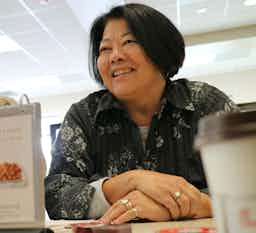
The fundamentals of retail merchandising

By Janet Cummings
2/16/2023
Overview
When you consider where your products are placed and what products they are paired with, you can build an effective strategy to increase your sales, while serving your customers.
According to Merriam-Webster, merchandising is “sales promotion as a comprehensive function including market research, development of new products, coordination of manufacture and marketing, and effective advertising and selling.” But what is merchandising as it relates to retail? In this instance, merchandising is a way of presenting products for customers to buy.
Together, we are going to explore merchandising and some things that I have learned throughout my thirty years in retail. While e-commerce may seem like a totally new game, it still follows the same basic rules. When you understand these rules, you will see how merchandising, inventory, and price work together to drive sales, reduce costs, and help your retail business, whether you are in a brick-and-mortar, online, or both.
What is the goal of retail merchandising?
Retail is about sales, but it’s more complex than that.
Short-term sales may drive revenue, but long-term profitability comes from serving customers over time. Acquiring new customers is expensive, so it’s important to serve existing customers. Quality service builds trust, and trust leads to repeat business. Merchandising is a great way to build trust with your customers. Trying to sell customers something that they do not need will eventually drive them away.
You can build an effective strategy to increase your sales while serving your customers by providing the products that they need and want when they need and want them
Taking the time to merchandise shows that you care. It’s a way to demonstrate that you know and care about your customers, by carrying the products that they need and want.
Effective merchandising increases sales. When you consider your customers, the seasons, where your products are placed, and what products they are paired with, you can build an effective strategy to increase your sales, while serving your customers by providing the products that they need and want when they need and want them.
How knowing your customers helps you merchandise
To figure out what to merchandise, start with your customers. Who are your customers and what do you know about them? What is their gender, age, income, and location? How often do they shop at your store and what are they typically shopping for? The amount of information available about customers making purchasing decisions is overwhelming. That’s why it’s important to focus on knowing your customer. Then, merchandise your products to make it as easy as possible for them to make a decision and buy.
Merchandise seasonally
When you are planning your inventory, think seasonally. Different retailers have different areas of focus. If you are in the jewelry business, for example, then Christmas, Valentine’s Day, and Mother's Day are big holidays for you. Knowing what people will want from you at different times of the year helps you determine how to stock the right products at the right time.
How to display products
The way that you display an item can either help or hurt it. In a traditional retail setting, you have pegs to hang products from, shelves to set products on, and bins to fill with products. The way that an item is displayed also helps increase its perceived value. Filling a bin with inventory that you need to move fast is fine, but you do not want to do that for higher-priced products, because bins feel like bargains.
You may have heard the term "facing items." That is when you go down an aisle and make sure that all of your products face the front, are fully stocked, and do not look picked over. People like to see fully stocked shelves. Online, this translates to clear photography, easy-to-read headlines, helpful body copy, and keeping inventory so that you are not always sold out.
Placement matters
I was always told to merchandise so that the largest of the same item is always on the right, because the majority of customers are right-handed. Always try to put the thing that you want to feature on shelves that are eye-level. For example, in the shampoo aisle, the promotional shampoos go on the bottom shelf, the popular higher-end shampoos go on the middle shelf, and the less-popular higher-end shampoos go on the top shelf. The same concept applies to online retail. Be intentional about what products appear where on your site to increase conversion.
What is in your aisle?
Think of aisles as the foundation of your store. The products in the aisle are organized by categories. The categories should be intuitive and help people find what they are looking for. When deciding what to merchandise, think about what products go together. Taking time to do this can help you identify products that draw customers in and make you money. As you think about the navigation of your site, are these products easy to find? Are they categorized intuitively, and is there a search feature to help shoppers find what they are looking for?
Merchandising loss leaders
In stores, there are three types of products—products that make you money, products that you break even on, and products that you lose money on (also called "loss leaders").
Understanding loss leaders is why merchandising is so important. You do not put all of your loss leaders together in a store; you merchandise them with the products that you break even on and make money on, pairing products to increase revenue and gross profit.
At one of my stores, I had a computer system that was able to generate reports that showed what the top products were by price and by highest gross profits. Using this data, I could, for example, generate an end cap with toilet paper, a bucket, and an impulse-buy toilet bowl cleaner. While I might not get as high of a gross profit, I might get an additional sale, which led to more revenue.
Merchandising end caps
There are a few helpful lessons that you can pull from end caps. The first lesson is that end caps are always changing. People do not want to see the same thing over and over again. End caps are a way to refresh your store while allowing your staples to remain in place.
End caps are also a way for you to sell slow-moving inventory. If you have too many paper towels, you can put them on an end cap and pair them with window cleaner and a squeegee. You would likely sell more paper towels because people would see them and remember that they need them, and then you would sell the other products that you paired with the paper towels because you reminded customers that it’s spring and their windows need to be cleaned.
Merchandising from brick-and-mortar to e-commerce
People have been buying and selling goods since the beginning of time. While technology has made shopping more convenient, it has also increased its complexity. As you think through your retail experience (whether it’s brick-and-mortar or digital), is your merchandising strategy helping or hurting your business?